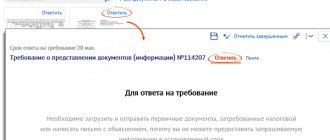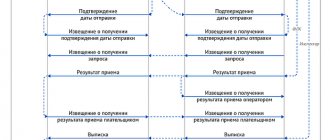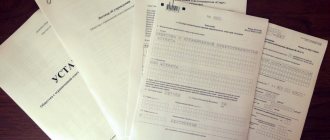Before you start working with documents, you need to carefully read the relevant instructions on office work and document flow. These are very complex standards containing many small nuances and details. It would seem that it could be simpler than stitching a document by hand and handing it over to the archives. But in practice this is absolutely not the case. The archive often does not accept a document if any rule of record keeping is violated. We have to do everything again.
If you are familiar with a similar situation, then our article will help you figure it out. We will consider in detail all issues related to the procedure for stitching a document: from GOSTs regulating this process to the design of the cover and stitching with 3 or 4 holes.
Filing according to form
Each organization gradually accumulates materials that, upon expiration, are subject to transfer to archival funds.
Usually, the file is handed over to the archivist after a year, after the completion of the paperwork. For this purpose, the case is prepared according to the form. This procedure includes several mandatory points:
- It checks how correctly the documents are distributed among the group.
- They sew the case together.
- Carefully check the correct numbering of the sheets.
- Make an accompanying inscription.
- Fill out the internal inventory.
- If necessary, correct the details included in the binding.
Filing of documents should be carried out by a person who has the appropriate authority to do so.
Execution control
The work of monitoring the execution of documents includes checking deadlines, regulating the progress and analyzing the results of document execution. The following types of control are distinguished: current, preventive and final.
Current control is the daily preparation of information that expires today. The assistant secretary reports to the manager every day at the beginning of the working day about the facts of failure to meet the established deadlines. Preventive control consists of promptly warning the employee 2-3 days in advance of the need to resolve the issue assigned to him. Final control is an analytical work to summarize the performance discipline in the organization. A form of control is the compilation once a month (quarter) of a list of outstanding documents for individual divisions (for large organizations) or for the organization as a whole. Based on the analysis of the delay in the execution of documents, the reasons are established and appropriate proposals are developed to correct the deficiencies.
Legislation
At first glance, the procedure for filing documents does not present any difficulty, but the fact is that there is no one common filing procedure for everyone. It is all the more interesting that an employee of a tax or archival authority has the right to return, in his opinion, incorrectly filed papers, but this circumstance only increases the time frame for paperwork, although there are approved GOST standards regulating this procedure.
- Despite the fact that there is no single standard for filing and certification of documents, there are, for example, “Methodological Recommendations”, which have developed instructions for office work in the federal executive body, regulating certain rules. According to them, filed documents in A4 format should be certified. These recommendations are spelled out in the Order of the Russian Archive number 76, signed on December 23, 2009, and in GOST R 51141-98 (on archiving and office work).
- If it is necessary to register a Limited Liability Company, documents should be drawn up in accordance with the relevant “Requirements …” No. 110, approved on February 26, 2004 for documentation used in the case of state registration of legal entities, as well as individuals, when registering individual entrepreneurial activities and the corresponding “Methodological explanations …” (Article 1, paragraph 3), explaining the order in which the document forms that must be used for state registration of a legal entity are filled out.
- Of course, when suddenly doubts creep in that everything is being done correctly, it probably makes sense to find out all the intricacies of the procedure at the place where the documents are to be submitted. Somewhere, in particular, page numbering and certification of each sheet are required.
Be that as it may, the general rule is the following: if a document contains two or more sheets, they must be stitched.
Designing the cover
As you know, theater begins with the wardrobe, and business begins with the cover. The first thing to do is choose a cardboard cover for the case. Although at first glance it seems that they are all the same, this is not entirely true. There are three types: standard, non-standard and cover for long-term storage :
- Standard ones are most common; their size is 229x324 millimeters. They are used when the sheets have a regular, standard size.
- Non-standard differs in size and is needed when a document for some reason has a specific, non-standard size.
- And the last type is a document that, according to legal regulations, must be stored in an archive for more than 25 years. It requires a hard cardboard cover. Since the storage period is quite long, care should be taken to ensure that the document is in proper form and is suitable for use after such a period of time. Acid-free cardboard covers are used for those documents that are subject to submission to the state archive.
You can view the rules and a sample of filling out a payroll slip using the T-49 form in this article.
If you are interested in what OKATO is, check out this material.
How to stitch documents correctly with thread
To staple a document you need to have:
- hole punch;
- with a strong thread, preferably a harsh one;
- parchment or regular paper sticker (tracing paper can be used).
The stitching process includes the following steps:
- On the certification sticker, the text indicates the number of sheets numbered, sealed and signed, the name of the company, the position of the authorized person, the date, his signature and transcript.
- Each sheet is carefully placed next to each other. Next, use a hole punch to punch out the required number of holes. When the document consists of two or three sheets, you can use an awl or a thick needle.
- If two holes are used, the thread is threaded through them so that the ends are at the back. The thread must be threaded twice for reliability.
- The tails of the thread are tied, left 5–6 cm long, the rest is cut off with scissors. The prepared sticker should cover the knot, but not hide it entirely. If the shelf life is over ten years, parchment paper (tracing paper) is used for stickers.
- The sticker is signed in advance, but sometimes it is stamped and signed after the glue has dried.
- When the document is stitched, it is certified on the last sheet on the reverse side with a signature by an authorized person responsible for submitting the prepared document to a tax or other structure. Sometimes you need to sign on every page.
Topic: Cash book from 1C for what period should I print and file?
Cash transactions (there are few of them, several per month - issuing salaries, advance reports) are conducted in 1C: 8 Accounting. The question is: how to print and file a cash book? How often? And what is the complete list of cash documents that should be there, and how should all this be filed?
Tell me, where to file expense reports? to the cash book or to store separately? And also, if the report is on a business trip, for the daily allowance I put a travel certificate, and should I file it in the report? Should I store all other documents related to the business trip in another place, or can I store the travel document separately from the expense report?
Flashing methods
There are usually three ways to stitch a document with threads: using three, four and five holes.
- In the first case, holes are punched three times on the sheets from the left edge at a distance from each other no more than three centimeters. Then the case is turned over and a thread is passed through the middle hole, the end of which remains outside on the back side of the document. Next, the thread is passed through the hole at the top, from there on the other side, through the hole at the bottom and again into the middle. As a result, the two ends of the thread will end up on the back of the document, where they are tied with a knot, onto which a piece of parchment paper with a seal and signature is glued.
- With four holes (about 1.5 cm between them), the case is turned over and the thread is pushed into the third hole from the bottom, then it is passed through the lowest hole and led up with a snake: through the second bottom hole, outside the case, into the third hole from the bottom, then threaded into the top one and again pass into the third hole from the bottom. At the back of the case, two ends are formed, which are tied and sealed with parchment or tracing paper.
- It is also possible to flash documents using five holes; the flashing mechanism itself remains the same.
Different documents are stitched in different ways:
- a five-hole system is used for accounting documents;
- for archival and tax purposes – out of three;
- For cash register materials, fastening is often carried out in the upper left corner;
Of course, you can use the general rules, but you should remember that some structures add their own nuances to this procedure, which must be taken into account.
Sheet numbering
Fold the case in the required sequence, then start numbering it. It is done with a simple pencil .
The basic rule is that it is not the pages that are numbered, but the sheets of the document . The number is placed in the upper right corner of each sheet using Arabic numerals. The numbers should not touch the text. In this case, the inventory is not included in the general numbering of sheets.
Let's look at some numbering points:
- If the document being filed contains letters, then the envelope itself is numbered first, then all the sheets enclosed in the envelope.
- If the document is quite large (more than 250 sheets), then it is divided into appropriate volumes. Each new volume has its own numbering.
- The file may contain documents that have their own page numbering, such as periodicals, etc. Despite this, they are also numbered in a general order.
- The larger sheet is unfolded and numbered in the upper right corner. It needs to be hemmed at one edge so that you can easily unfold and read the text of the document.
- Regarding sheets on which other fragments are glued and which cannot be separated, such sheets are numbered as one. But in this case, you need to make an inventory of the glued fragments in the free space or on the back. When compiling a general inventory, it is indicated in the notes or in the certification inscription that a document (its name) is pasted on such and such a sheet, about which the inventory is drawn up on the sheet. This can usually be photographs, receipts or clippings. If such a document is stapled or glued at one edge, then it is numbered in the same way as all the others. Information about this is not indicated in the inventory.
- Specific documents, for example, drawings, photographs, diagrams, occupying the entire sheet, are numbered on the back of the sheet in the upper left corner.
- Maps or diagrams can be glued together from several sheets, they have one number, but in the notes it is necessary to write the number of sheets in such a glued together.
If minor errors were identified during the numbering, that is, one or two sheets were missed, then letter designations can be used instead of renumbering all the sheets. For example, instead of the missing sheet 12, following the eleventh, put the number 11a. Other sheets do not change their number. Errors can be corrected in this way only by agreeing on this correction with an archive employee.
If there are gross errors, the document must be renumbered. The previous number is carefully crossed out and a new one is added. A certification note must also be made for the new numbering. The old inscription remains, but it should be crossed out.
3.6. requirements for registration of cases accepted into the archive
When the stitching is completed, the needle and thread are inserted into the central hole and brought out to the back of the assembled documents. The remaining end of the thread must be tied in a knot. The documentation is sewn together with bank twine, thin Mylar tape or stitching threads. How to sew documentation with thread Preparing accessories:
- needles and thread of suitable thickness
- documents that need to be flashed
- an awl or other tool for making holes in paper
- organization seal
- stationery glue
We stitch the document in 3 stages:
- We are preparing papers for stitching.
What documents are stored in the employee’s personal file?
Personal files should be kept in a place that allows limited access to them. These can be either separate rooms or metal locked cabinets (safes). The files of dismissed employees are stored separately from existing ones, and after three years they are transferred to the archive (for civil servants - after 10 years).
Such a dossier is a long-term storage document. Therefore, there is no need to file documents with a shelf life of less than 5 years (applications and orders for vacation, time off, certificates from place of residence, health status, etc.).
How to lace and number a logbook correctly: sample
- The logbook is bound using hardcover. This is necessary to maintain the proper appearance of the document for a long period of storage.
- Documents are numbered.
- The log book is stitched with regular coarse thread without complying with any regulatory requirements.
How to lace and number a logbook correctly: sample
For firmware you can use the following materials:
- bank twine
- regular thread No. 10 (stitched with a large number of stitches)
- thin long cord
- raw or stitching thread
- the bound document is sealed to protect records from outside interference
Logbook firmware process:
- prepare three holes with a hole punch or awl (make holes on the left in the margins of the magazine)
- insert the thread from the back of the magazine binding into the outer hole
- bring the thread to the front side and pull out the edges, aligning them
- insert the ends of the threads (the segment should be 6-8 cm) into the hole that is located in the center and pull it to the back side
- if you use a thread that is not strong enough, repeat the procedure
- We tie the ends of the threads with a knot on the back side, grabbing the central thread that passes through the outer holes
- glue the ends of the threads to the magazine, and glue a small square piece of paper on top, on which the responsible person signs and signs
- indicate the firmware date
>Firmware documents for archive
You will learn about the features of flashing documents for the archive in the video.
>How to flash a folder with documents?
The process of flashing a folder with documents is shown in the video.
>Video: Filing a case >How to sew a case?
Watch the video to see how to properly file a case.
What documents to file in a folder - Accounting
Not the most convenient option, especially when there is more than one accountant in the organization. In addition, in order to conduct an audit of the cash register or warehouse, you will have to sift through all the documents. Or in the case of checking the cash register of the Federal Tax Service, the same problem again, or checking funds. True, if the task is to “poison the lives” of inspectors from the Social Insurance Fund or the Pension Fund of the Russian Federation, then this method of filing documents is very convenient, let them dig around.
Most often, documents are filed by subject: cash desk, bank, settlements with accountable persons, settlements with suppliers, etc. Accounting registers can be filed by subject, for example, the register for account 50 can be filed in the “Cash Office” folder, or all accounting registers can be filed in separate folder, a matter of taste.






